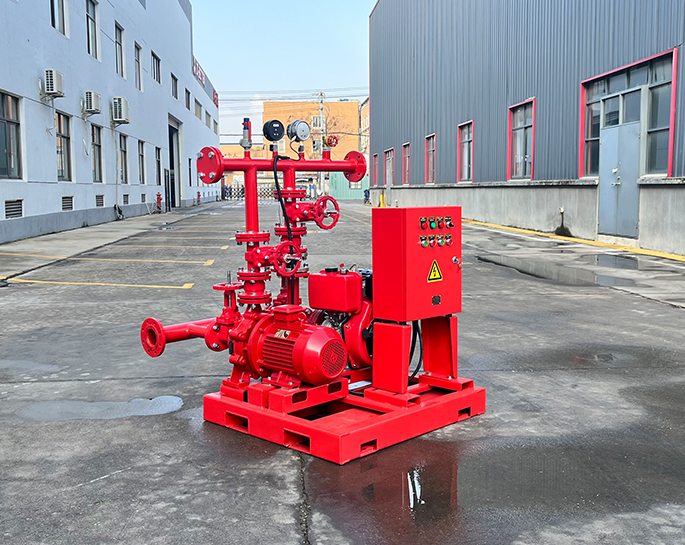How are fire pump systems tested for resilience against power failures or electrical faults?
Feb 01, 2024
Share:
Testing fire pump systems for resilience against power failures or electrical faults is crucial to ensure their reliability in emergency situations. Here are some common methods and considerations for testing:
1. **Primary Power Failure Test:**
- Simulate a power failure to the primary electrical source of the fire pump.
- Monitor and evaluate the response of the fire pump system as it transitions to an alternate power source, such as a backup generator or an uninterruptible power supply (UPS).
- Verify that the transition is seamless and does not compromise the system's ability to deliver water to the fire protection system.
2. **Generator Load Test:**
- If the fire pump relies on a backup generator, perform regular load tests on the generator to ensure it can handle the required electrical load during an emergency.
- Confirm that the generator starts promptly, reaches the necessary RPM (Revolutions Per Minute), and maintains stable power output.
3. **Battery Backup Test:**
- If the fire pump system incorporates battery backups, conduct regular tests to verify the functionality and capacity of the batteries.
- Ensure that the batteries can sustain the fire pump system for the required duration during a power failure.
4. **Automatic Transfer Switch (ATS) Test:**
- Verify the proper operation of the ATS, which is responsible for automatically transferring the electrical supply between the primary and backup sources.
- Test the ATS under different scenarios, including simulated power failures and restoration of primary power.
5. **Electrical Fault Simulation:**
- Intentionally simulate electrical faults, such as short circuits or ground faults, within the electrical components of the fire pump system.
- Evaluate the system's response to these faults and ensure that protective devices, such as circuit breakers, function as intended.
6. **Remote Monitoring and Alarms:**
- Implement a remote monitoring system that continuously monitors the status of the fire pump system.
- Configure alarms to alert personnel in the event of power failures, electrical faults, or any other issues that may affect the system's performance.
7. **Periodic Maintenance:**
- Establish a routine maintenance schedule to inspect and test all electrical components, connections, and control panels.
- Replace or repair any components showing signs of wear or deterioration.
8. **Documentation and Recordkeeping:**
- Maintain detailed records of all tests, inspections, and maintenance activities.
- Keep records of any modifications or upgrades to the fire pump system.
By regularly conducting these tests and implementing a comprehensive maintenance program, fire pump systems can be better prepared to handle power failures or electrical faults, ensuring their resilience and reliability when needed most.

1. **Primary Power Failure Test:**
- Simulate a power failure to the primary electrical source of the fire pump.
- Monitor and evaluate the response of the fire pump system as it transitions to an alternate power source, such as a backup generator or an uninterruptible power supply (UPS).
- Verify that the transition is seamless and does not compromise the system's ability to deliver water to the fire protection system.
2. **Generator Load Test:**
- If the fire pump relies on a backup generator, perform regular load tests on the generator to ensure it can handle the required electrical load during an emergency.
- Confirm that the generator starts promptly, reaches the necessary RPM (Revolutions Per Minute), and maintains stable power output.
3. **Battery Backup Test:**
- If the fire pump system incorporates battery backups, conduct regular tests to verify the functionality and capacity of the batteries.
- Ensure that the batteries can sustain the fire pump system for the required duration during a power failure.
4. **Automatic Transfer Switch (ATS) Test:**
- Verify the proper operation of the ATS, which is responsible for automatically transferring the electrical supply between the primary and backup sources.
- Test the ATS under different scenarios, including simulated power failures and restoration of primary power.
5. **Electrical Fault Simulation:**
- Intentionally simulate electrical faults, such as short circuits or ground faults, within the electrical components of the fire pump system.
- Evaluate the system's response to these faults and ensure that protective devices, such as circuit breakers, function as intended.
6. **Remote Monitoring and Alarms:**
- Implement a remote monitoring system that continuously monitors the status of the fire pump system.
- Configure alarms to alert personnel in the event of power failures, electrical faults, or any other issues that may affect the system's performance.
7. **Periodic Maintenance:**
- Establish a routine maintenance schedule to inspect and test all electrical components, connections, and control panels.
- Replace or repair any components showing signs of wear or deterioration.
8. **Documentation and Recordkeeping:**
- Maintain detailed records of all tests, inspections, and maintenance activities.
- Keep records of any modifications or upgrades to the fire pump system.
By regularly conducting these tests and implementing a comprehensive maintenance program, fire pump systems can be better prepared to handle power failures or electrical faults, ensuring their resilience and reliability when needed most.







